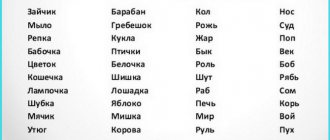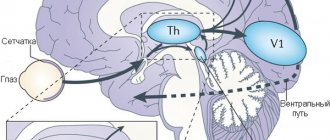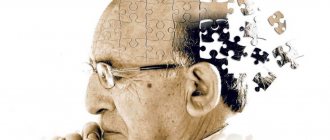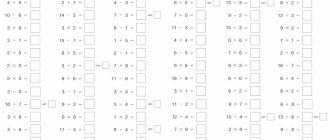By visual memory we mean a special type of memory that is responsible for recording and reflecting visual images, as well as for their use in the process of communication.
Visual memory is responsible for storing and reproducing received visual images. With its help, we remember people's faces, navigate the area and recognize objects. When we see a person's face, our brain undergoes a complex process of comparing this visual image with those already stored in our long-term memory. If the images coincide, then we identify this person as an acquaintance. This entire process happens in a matter of seconds.
It also happens that when we meet a person for the second time, we cannot immediately remember when and under what circumstances we saw him. There are also people who find it difficult to recognize the face of the person with whom they spent the whole day. One of these people is mentioned in the documentary “My Extraordinary Brain. Make me a genius."
The main character of the film had a phenomenal visual memory, which was by no means given to her by nature. This result was a reward for hard training that lasted for years. We highly recommend watching this film if you haven't seen it yet.
It should be noted that visual memory is very related to imagination. Therefore, by developing your imagination, you contribute to the development of visual memory, and vice versa.
Visual memory training
So how to develop visual memory? Fortunately, this can be done with the help of special training exercises and games to develop visual memory.
For example, to train visual memory, you can perform the following tasks:
Use the Spot the Difference pictures.
This is one of the most popular tasks, and there are many of them on the Internet.
Sometimes we think that this is just child's play, but this exercise helps us pay attention to details, which subsequently leads to better memorization.
Remember and describe people's appearance.
Each of us has many acquaintances. Of course we will recognize them. But we are unlikely to be able to fully describe their appearance and facial features the first time. Try to make an identikit or describe in detail at least one of the people closest to you. You will see that it is not so simple. But nothing is impossible either, try, and over time it will turn out better and better.
Draw from memory.
Try to make sure that you always have a notepad and pencil at hand. Try, in your free minutes, to redraw tree branches, a subway map, curves on a stone... First redraw, and then draw from memory. Try to maintain all proportions and line thickness. Of course, you can draw anything you want. Drawing in itself is an exercise for developing visual memory. In this case, it is not so much the ability to depict well that is important, but the desire to transfer remembered images from memory to paper as accurately as possible.
Use matches as auxiliary material.
Take a few matches (5 is enough to start with) and throw them on the table. Look at the shape they formed. Then turn away and try to reproduce the same figure using other matches. Compare how similar they are. If you do well enough with 5 matches, try increasing their number.
Connect other senses.
Imagine what this or that object would sound like, what color the number or letter would be. By connecting sounds or smells to visual images, you will enable your brain to better retain them in memory.
Remember the events of the past day
Before going to bed, remember the events of the past day in the form of “pictures”, “scroll through the event feed”, trying to clearly “see” all the details. As you can see, no special preparations are required for such a workout. Only a habit, if you decide to do it.
Memorizing an item
Find an object that pleases you and look at it for 3-5 minutes. Then close your eyes and try to imagine this object as brightly and clearly as possible. Give this approximately 3 minutes. Try again and again. When it seems like it’s working out, move on to the next stage: prepare a sheet of white paper, place it behind you, and after studying the object, turn your back to it and look at the white sheet, try to “see” a clear image of this object on it.
Cognitive trainers
Use online games to develop visual memory. On our website you can develop visual memory with the help of special gaming simulators.
Memorization Features
Vision becomes the first way of contact with the outside world for young children. With its help, they begin to remember everything that happens around them and perceive other people. After this, other types of memory are used.
An adult has already formed intelligence and certain abilities. Many people might say that their visual memory is not that good. In such cases, you can use special exercises and try to correct the situation.
Anyone can test themselves if they wish. A simple exercise will show how developed your visual memory is. Given its results, it will be possible to decide whether it is necessary to train memorization using the eyes at all. The essence of the test is as follows:
- The assistant must select 10 different images. Any pictures that have significant differences between them (for example, different animals) will do. It is advisable to print them out and cut them into small cards.
- The test taker’s task is to look at all the pictures as clearly as possible. He is given only 20 seconds to do this. When the time is up, you will need to name everything that was seen on the cards.
The assistant must listen carefully to the test taker and draw conclusions about the quality of his memory. Most often, this test is used for children, because for many adults is not so difficult. Nevertheless, it will definitely be possible to identify bad memory with its help. If you want to complicate the task, then you can use more specific cards or create additional conventions.
Visual memory improves every time a person actively uses it. Its formation begins in childhood and continues throughout life. Therefore, it is especially developed among those people whose profession often requires visually remembering various things and documents.
People with well-developed visual memory are distinguished by increased attentiveness and the ability to concentrate easily.
Visual memory in children
Even in preschool age, children actively involuntarily memorize words, objects, concepts, images, therefore, during the “child-why” period, it is especially favorable to use special games designed to train visual memory in children. This will prepare the child well for school and will help him perceive complex and voluminous information. Voluntary memory requires effort and the manifestation of attention and will to remember, this also applies to voluntary visual memory. General recommendations for good memorization are:
- What is interesting, bright, and emotionally presented is remembered better.
- The beginning and the end are the most memorable moments.
- What is explained simply and clearly will be remembered better.
- If, in addition to visual, other types of memory were involved (tactile, auditory, motor, etc.), then memorization will be more effective. The most common are mixed types of memory, especially visual-motor or, as it is also called, visual-motor memory.
Development methods
There are many ways to develop visual memory. Even simple tests like “Find 10 differences” are excellent for stimulating the brain. To develop memory, numerous techniques are used to stimulate abilities, for example, drawing from memory, describing a picture or photograph after looking at it for a short time, and an exercise to reproduce surrounding objects.
They come up with a simple, exciting task for children. On the way home from school, they remember everyone they meet and then describe it to their parents. Rewarding success will encourage intensive exploration of the world. The method improves children's attentiveness, helping to develop and improve skills.
For kids, describing pictures in children's books, sculpting figurines of pets from memory is suitable, and for older children - a card game to develop good visual memory.
To interest the baby, classes are made attractive for age and regular. Then the results will be impressive within a month after the start of training.
Diagnostics of visual memory
To diagnose visual memory in children at home, you can use, for example, a technique called “Ten Pictures”. To do this, prepare a sheet with small pictures of objects or animals pasted on it. You can use drawings instead of pictures, but they must be recognizable. Let your child study the pictures for 50 seconds (alternatively, you can use individual pictures, in which case each should be looked at for 5 seconds).
Then take the piece of paper and ask them to name all the images from memory. The order doesn't matter. This tests short-term visual memory. If a child remembers at least 8 images, this is an indicator of good visual memory. From 4 to 7 images is medium, and 3 or less is low. This test can also be used to determine the volume of visual memory. We’ll tell you how below.
Age-related features of short-term visual memory
Memory is an integrative function of the brain that provides perception, memorization, storage and reproduction of information or skill. In short-term memory, the most significant elements of perceived information are stored for a period of several seconds with the intention of its subsequent reproduction. From instant memory, it receives only that information that is recognized, correlates with the current interests and needs of a person, and attracts his increased attention. In this work, the object of research was the indicators of short-term visual memory of students studied in 2015 at the age of 18 to 23 years and in children in 2021 at the age of 3 to 6 years. The research was carried out at the Educational Institution "Gomel State University named after Francis Skorina" on the basis of the Department of Zoology, Physiology and Genetics, in nursery school No. 104 and the Health Institution "Gomel Children's Regional Hospital for Medical Rehabilitation".
The study of short-term visual memory was carried out using the following methods: Method 1 “Determination of the volume of short-term visual memory.” Memory capacity was assessed in points corresponding to the number of unrelated words reproduced out of 25 presented for visual memorization within 1 minute. Method 2 (according to Ebbinghaus) “Determination of the volume of short-term visual memory at different levels of meaningfulness.” Memory capacity was assessed by the sum of memorization coefficients based on the results of three tests performed according to Method 1 with the presentation for memorization of first unrelated, then semantically related words and, finally, syllables.
Table 1
Criteria for assessing the volume of short-term visual memory
| Point (method 1) | Memorization coefficient for each test (method 2) | Memory |
| Less than 7 | less than 0.28 | Short |
| 7–12 | 0,28–0,48 | Below the average |
| 13–17 | 0,49–0,68 | Average |
| 18–21 | 0,69–0,84 | Great |
| More than 22 | more than 0.85 | Phenomenal |
table 2
Criteria for assessing the volume of short-term visual memory in preschool children
| Point | Memory |
| 10 points | Very tall |
| 8–9 points | High |
| 4–7 points | Average |
| 2–3 points | Short |
| 1–0 point | Very low |
Visual memory is associated with the storage and reproduction of visual images. It is important for people of any profession, especially for engineers and artists. This type of memory presupposes a person’s developed ability to imagine.
Research results. The significance of differences between the coefficients of the meaning of syllables, unrelated words and related words was assessed using a two-sample t test. The arithmetic mean of unrelated words is 0.330.02 with a standard deviation of 0.19. The arithmetic mean of related words was 0.370.02 with a standard deviation of 0.2. The arithmetic mean of the syllables is 0.310.02 with a standard deviation of 0.17. No significant differences were found between the samples. From this histogram, we can see that students have the best retention rate for related words.
Rice. 1. Graphic interpretation of data to determine the reliability of the difference between the significance coefficients of syllables, unrelated words and related words among students
Also, using statistics, graphs were made based on the data obtained during the research. The influence of age and gender on the short-term visual memory of children was revealed and the volume of short-term visual memory of children of primary preschool age and students was compared using the same method “Remember the pictures”.
Rice. 2. Graphic interpretation of one-way analysis of variance of the effect of age on children’s short-term visual memory
Rice. 3. Graphic comparison of data from children and students using the “Memorize the pictures” method
Research findings. In studies of the volume of short-term visual memory, it was found that its average indicators in groups vary from 7 to 12 points, which corresponds to low and below average memory capacity and is confirmed by the results of studies using the Ebbinghaus method. The average value of the memorization coefficient significantly increases in all groups with meaningful memorization: when memorizing syllables it is 0.32; words unrelated in meaning ─ 0.34 and words related in meaning ─ 0.38. Significant differences were revealed in the values of the memorization coefficient of different groups: from 1.1 ± 0.3 to 0.4 ± 0.1 with an average value of 0.8 ± 0.2, which indicates individual variation in the indicators of short-term visual memory in the groups. The results of two-factor analysis of variance indicate a significant influence of children’s gender and age on short-term visual memory. At the same time, the influence of gender is most noticeable—Fisher’s test is 27.62 at a significance level of >0.01. Moreover, 59.7% of the variance variation is due to random influence. Age shows a less pronounced effect compared to gender - Fisher's test is only 0.82 at a significance level of 0.48, which is associated with minor differences in short-term visual memory. The results of one-way analysis of variance indicate that there is no effect of the age of preschool children on short-term visual memory - Fisher's criterion is 1.19 with a significance level of 0.31. Moreover, only 4.4% of the variance variation is due to the influence of the factor being studied—age. It is obvious that with a larger range of ages and coverage of younger schoolchildren in the study, the influence of the factor under study would exist, since older children are more motivated and their processes of inhibition prevail over the processes of excitation to a greater extent, and their nervous system is more developed.
When studying the short-term memory of students and preschool children using the unified “Remember the Pictures” method, it was revealed that the short-term visual memory of students is significantly higher than that of preschoolers. The influence of the factor under study occurs because older children (young men) are more motivated and their processes of inhibition prevail over the processes of excitation to a greater extent, their nervous system is more developed than that of preschool children.
Literature:
- Zhuchenko, Yu. M. Statistical processing of information using personal computers / Yu. M. Zhuchenko. Ministry of Education of the Republic of Belarus, Gomel State University named after. F. Skorina. — Gomel: GGU im. F. Skorina, 2007. - 105 p.
- Evtukhova L. A. Physiology of higher nervous activity: a practical guide for 5th year students of specialty 1–31 01 01–02 “Biology (scientific and pedagogical activity)” / L. A. Evtukhova, T. V. Bobrik, G. A. Medvedev; M-in image. RB, Gomel State University named after F. Skorina. — Gomel: GGU im. F.Skorina, 2010. - 72 p.
- Danilova, N. A. Physiology of higher nervous activity / N. A. Danilova, A. L. Krylova. — Phoenix Publishing House; 2005. - 478s.
- Bezrukikh, M. M. Age-related physiology / M. M. Bezrukikh, V. D. Sonkin. - M., 1990. - 416 p.
- Anokhin, P.K. Biology and neurophysiology of the conditioned reflex / P.K. Anokhin. - M., 1968.
Visual memory test
Various methods are widely used as a test for visual memory in children. To study visual memory, let’s consider one of the most accessible tests, and for this we will return to the already familiar one, called “Ten Pictures”. In this case, individual pictures are used to diagnose visual memory capacity. Each one is shown for 5-6 seconds, they are asked to name everything remembered from memory, but the testing does not end there. As you answer, pay attention and note the following points:
- were there any repeats?
- Were there imaginary objects or animals that were missing from the images shown?
- What is the number of correctly named images?
After this, show your child all the pictures that he did not remember. After 10 minutes, ask your child to remember all the pictures. The results are assessed as follows: if the child remembered 8-10 pictures, this is a good result; 5-7 is satisfactory, and 5 or less is unsatisfactory.
To determine visual-spatial memory, you can, for example, show the child for a short time a sample of a schematic drawing of a table (chair, bed, etc.), ask him to look at it carefully and then draw the same one.
Workouts for children
A child may not develop as quickly as his parents would like. Much depends on individual characteristics and genetic predisposition. Therefore, some children have rather weak visual memory, which must be improved. The easiest way to do this is with the help of special exercises that arouse their interest.
Exercise 1
The first type of training is very effective for developing visual memory and attention in young children who have not yet started school.
The essence of the training is as follows:
- Parents lay out a pattern of matches and buttons and show it to the child for 10 seconds.
- The child must create the same image without referring to the parents' pattern.
If it is too difficult for the baby, then the task can be simplified by reducing the number of elements. You can also use other items instead of matches and buttons.
Exercise 2
Training with this method is more like a game. Before performing it, parents must prepare cards with different stars, which differ in internal patterns and sizes.
The exercise goes like this:
- Parents give the child one star for 10 seconds to look at, and then take it away and mix it with other cards.
- Next, they lay out all the cards in front of the child, and his task will be to find an already familiar star.
It's best to start with 6 cards, but you can make many more. It all depends on the age and abilities of the child.
Exercise 3
This is one of the most favorite exercises for children. To complete it, parents must find any picture that has many different elements.
The training is carried out as follows:
- Parents show the child a picture for 30 seconds.
- After that, it is removed and the baby is asked questions regarding what he saw.
Questions may be about the quantity of certain things, their colors, location, etc.
Exercise 4
The difficulty of this exercise is determined by the parents, taking into account the child's skills. They must draw 3 different trees in advance, consisting of geometric shapes.
You need to do the training like this:
- Parents show the child a picture with 3 trees for half a minute.
- The child’s task will be to draw the tree whose number the adults will name.
To complicate the task, you can use different colors. But this is recommended only for schoolchildren.
Exercise 5
A very simple workout that is suitable for preschoolers. Parents should collect small cards of different colors in advance. It is important that the colors are as distinct from each other as possible.
How to do it:
- Parents lay out the cards in a certain order and show them to the child.
- After 10 seconds, the cards are closed, and the baby must remember their order.
If the child cannot cope with the task, then it is allowed to reduce the number of cards, as well as replace the colors with numbers or pictures.
You can also use simpler tasks. For example, give a child two similar pictures in which you need to find the differences.
Visual memory capacity
The volume of visual memory is an important indicator on which the possibility of storing a particular amount of imprinted information depends. To determine the volume of short-term and operative memory, there is the following technique: the child is alternately asked to study two drawings, which are randomly arranged broken lines consisting of 9 segments.
After memorizing each of these two drawings, the child is offered a stencil frame on which he must display as accurately as possible from memory the lines depicted in each of the drawings. Based on two experiments, the average number of lines correctly reproduced from memory is determined.
This indicator is taken as the volume of visual memory. Correct reproduction means a deviation from the original pattern in length by no more than one cell in each line, while maintaining the correct angle of inclination.
Working visual memory shows how long a person can retain and use information necessary to solve a problem. The indicators of a child’s visual operative memory are determined, for example, using the following test: the child is asked to look at cards in the form of six differently shaded triangles for 15 seconds. Then the child receives a matrix of 24 different triangles (4 cards of 6 triangles each) and finds among them those that he memorized on six cards initially. Dividing the amount of time required to solve (in minutes) by the number of errors and adding one, we obtain the desired value - an indicator of the development of visual RAM.
Types of visual memory
As the Chinese proverb says: “It is better to see once than to hear a thousand times.” Visual memorization can be classified according to the following parameters:
- duration of preservation and consolidation of the image;
- goal setting;
- way of remembering.
The duration of work with a memory image can be short-term or long-term. Short-term - implies only the fact of fixation, and long-term - fixing the picture in memory for a long time.
There are two types of target setting:
- deliberate - when special methods are used to achieve the goal of remembering something;
- unintentional - there is no specific goal to remember, and the fixation of images occurs without additional effort.
Proven. Remembering what a picture of a complex formula looks like (its entire visual appearance) is easier than remembering its detailed writing.
Certain types of salary
Visual memory impairment
As a rule, memory impairments are associated with stress, overwork, and they can also be a consequence of somatic diseases. Alcoholism is scary because it affects the liver and leads to hypovitaminosis. In addition, alcoholism affects brain structures. Memory impairment is also caused by cerebral circulatory disorders, cerebral vascular spasms, and age-related changes.
Visual memory disorders are associated primarily with trauma or tumor processes, which primarily affect the occipital zones of the cerebral cortex. This is expressed in a disorder of visual perception and difficulty in recognizing objects and objects perceived before, or if, when recognizing and understanding the purpose of an object, there are difficulties in naming it.
In some cases, insufficient development of visual memory may be associated with insufficient maturity of certain neural structures of the brain or visual analyzers in childhood and adolescence, or diseases and disorders of these structures. In this case, to study visual memory, taking into account specific nuances, you need to consult a medical specialist (neurologist, ophthalmologist, neuropsychologist).
Kinds
There are many ways of classification, but they are all part of the same innate memory mechanism. This is achieved in different ways - through touching, looking, tasting, smelling, hearing, and so on. As a result of learning about the world, a person develops imaginative thinking, which subsequently allows him to process and generate abstract information, that is, obtained as a derivative of previously acquired knowledge.
WE RECOMMEND SEEING: How to help a child if he has a bad memory
Visual memory can be divided into the following types:
- Super short-term, or iconic. It allows you to receive instant information, which is “erased” if it is not immediately used. Its duration does not exceed one second.
- Short-term. Its duration is up to 30 seconds.
- Long-term. It is she who helps us preserve wonderful memories from childhood, the most striking events, faces, places and sensations. It lasts a very long time, but with age and in the presence of a number of diseases it begins to “wear out”. Some memories are erased, while others fade and are not remembered as vividly and with such an abundance of details as before.
Eidetic memory
Memory in psychology is a person’s ability to remember, store, reproduce, and also forget events, phenomena, contacts, knowledge gained from the individual’s own experience.
The so-called eidetic memory is classified into a separate group. This type of perception can be called photographic, because an individual who has this ability has the ability to hold a bright and clear image of what he saw for a long time, and also successfully reproduce it in the form of a drawing or verbal description.
This type of perception is not characteristic of all people. To a large extent, it is inherent in children, adolescents and people with an artistic personality type - poets, writers, artists, musicians, actors. Such unique abilities were possessed by American President Ronald Reagan, who was an artist all his life before entering politics. To memorize extensive text, all he had to do was look at it.
Features of visual memory
The peculiarity of visual memory is that in the process of holding a visual image in memory, it undergoes certain changes and is transformed. This could be, for example, simplification, ignoring some details, or exaggerating certain nuances, or changing in favor of greater symmetry, or changing shape (rounding, narrowing, or changing position in space), or changing color. These inaccuracies inherent in visual figurative memory can be both a disadvantage and an advantage, because in this way you can simplify the image, make it symbolic, bright, and unexpected.
A good visual memory presupposes a well-developed imagination. The process of memorizing material and reproducing it is largely based on this, because what we can easily imagine visually is, as a rule, easier to both remember and reproduce.
Mechanisms of formation
In neurophysiology, memory is considered as a property of the central nervous system, which consists in storing information about events occurring in the environment, the body's reactions to them, and the ability to repeatedly reproduce and correct mentally imprinted information. The development of visual memory is impossible without the use of a technique such as repetition, which enhances memorization.
The psychophysical and neurophysiological mechanisms of the memorization process are based on the perception of an object in the external world as a set of specific features encoded into a single, integral image. The sensitivity of the system that recognizes objects stored in memory varies from person to person. Extraction of the desired object from the depths of memory is carried out using stimuli that are perceived by neurons in the associative areas of the brain.
Researchers have discovered that visual memory stores information about a large number of objects and partly about their properties. As part of the test task, subjects, after viewing a catalog of 10 thousand photographs, in 83% of cases choose a previously seen photograph from two alternative options (one is present in the catalog, the other is not). Moreover, the time allotted for the initial viewing of the catalog is several seconds.
Another experiment involved subjects being shown a catalog of 2.5 thousand photographs, divided into categories, for a certain period of time. Initially, the subjects were tasked with remembering more detailed information about the presented objects. The test task involved the presentation of a previously shown stimulus in 3 options: paired with an object from a different category, paired with an object from the same category, the same objects in a different position or in a different state.
The subjects correctly identified the stimuli presented during initial and repeat viewing in 92%, 88%, and 87% of cases, respectively. The experiment confirms a person's ability to remember specific characteristics of an object.
The mechanism of memory is built on automatic and conscious thought processes. In the first case, a person subconsciously experiences the feeling that the object is familiar to him, in the second, he purposefully tries to extract information from memory.
Instrumental diagnostics (EEG, electroencephalogram) of visual memory function showed negative wave activity in the frontal region of the brain when a feeling of familiarity arises in relation to an object. When trying to purposefully remember, positive waves arise in the parietal and central areas of the brain. Testing visual memory in patients with brain damage in the temporal lobe showed difficulties in recognizing visual images.
With damage to the frontal lobe, subjects retained the ability to recognize visual patterns, but had difficulty performing tasks related to spatial memory. To exclude pathologies that affect the deterioration of perception and memory of visual images, it is recommended to undergo examination by specialist doctors: an ophthalmologist, a neurologist.
Development of visual memory online
What improves memory? Games for the development of visual-spatial memory (for example, “Way of the Ninja”) sharpen the ability to remember the location of objects (shaded cells on the field) and require efficient functioning of the hippocampus. This is a great workout for the brain.
Developing visual memory online is one of the effective ways to train. it’s convenient: it’s enough to have at least a smartphone with the Internet, which today is no longer a problem. Training with online brain simulators is an accessible and fun way to develop not only visual memory, but also its other types, as well as attention, perception and thinking. The opportunity to observe the dynamics of your success, tangible changes for the better, visual statistics, participation in tournaments, and a competitive spirit will turn routine activities into a daily exciting game, very useful and effective.
Development
In psychology, special attention is paid to the development of visual memory, since it is considered the basis for all other types. It is believed that if its level is high enough, there will be no problems with mnemonic abilities in general. So train it at any age.
In children
Images
The most popular, beloved and quite effective method for developing a salary is “Find 5/10 differences.” The child is shown two similar pictures, and he needs to find the details in which they differ. The older the children, the more little details must be depicted in the illustration and, accordingly, the number of differences that need to be detected increases.
Pictures are the most effective method for developing mental intelligence at any age. Invite children to complete the symmetrical pattern on the wings of a butterfly from memory or discover what is wrong in the illustration (for example, the dog does not have a tail, the guys play football without a ball, etc.).
Games
Since play is a leading activity for children, use it to train visual memory. One of the most fun is “Detectives”. The kids must carefully examine the room, then they all leave it, and the presenter either removes some object, or adds and invites the young Sherlock Holmeses back. Whoever notices the changes first is declared a super detective.
When it comes to children's board games, the best way to train your brain is to do puzzles and mosaics. Moreover, tactile sensations are also involved here.
Visual memory games
You can help your preschool child develop good visual memory and at the same time train or test your own. We offer several games for visual memory:
Name the picture
Prepare 10-12 pictures, place them on the table and look at them with your child for 1 minute. Then hide or cover the pictures and take turns with your child to name one at a time, without repeating. The one who cannot name the remaining picture will lose.
What changed?
Prepare about 8 small items or toys. A pencil, a pen, an eraser, a block of plasticine, a typewriter, a hairpin, a coin, a button, etc. will do. Place the objects on the tray, let the child look for 40 seconds, ask him to turn away and change something (remove, add or change the arrangement of objects). So what has changed? Swap places with your child, now it’s your turn.
Draw from memory
Prepare several sheets of paper and a pencil. On one sheet of paper, draw a simple figure or pattern, show it to the child for 20-30 seconds, remove it, and ask him to draw from memory. See what happened together. Now you.
Games to develop visual memory can become a useful habit, a part of life, as natural and integral as exercise or washing your face. And you will learn to notice details, instantly “grab” them and retain them in memory. In addition, exercises for developing visual memory can become a favorite joint activity with children. Don’t be upset if something doesn’t work out right away: behind any achievement there is hard work. But it is in your power to make it exciting, turn it into a game, and fall in love with it.
We sincerely wish you success in self-development!
How to improve visual memory without wasting additional time?
Few people like to do exercises to train their memory, but you can improve it without spending extra time. There are several recommendations that, if followed, can significantly improve visual memory.
- Memories. To develop visual memory, you need to reproduce the events of the past day in as much detail as possible every day before going to bed, placing special emphasis on images and small details. By doing this exercise every day, you will quickly notice that the number of details that you can capture increases in number.
- You can constantly train your memory, especially if your profession involves contact with people. To develop visual memory, you need to try to reproduce in your head the details of the image of a person with whom you just communicated or even whom you simply passed by.
- Instant. Throughout the day, you can stimulate your visual memory by stopping unexpectedly or simply looking at an object, such as a painting. After looking at it for a couple of moments, you need to close your eyes and try to reproduce in your thoughts as accurately as possible everything that you managed to remember.
- Verbal portrait. This exercise is also helpful for people who have problems with visual memory. When getting to know a person, you should mentally describe the main details of appearance and behavior verbally. At the same time, you need to try to pay attention to many even small details. After which, after some time, you need to try to reproduce the verbal portrait in the form of an image.
Such simple exercises will help achieve stunning results in the development of visual memory. In addition, attentiveness and concentration will improve, and therefore, overall intellectual capabilities will increase.











